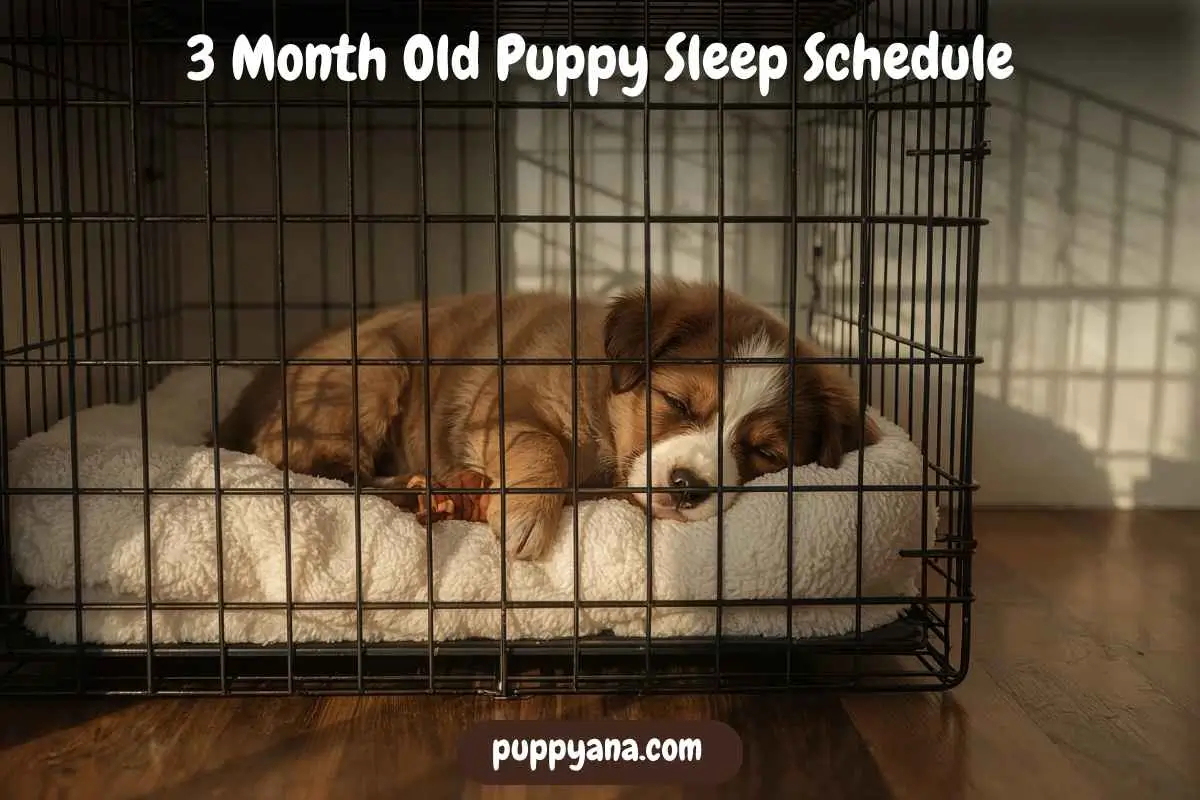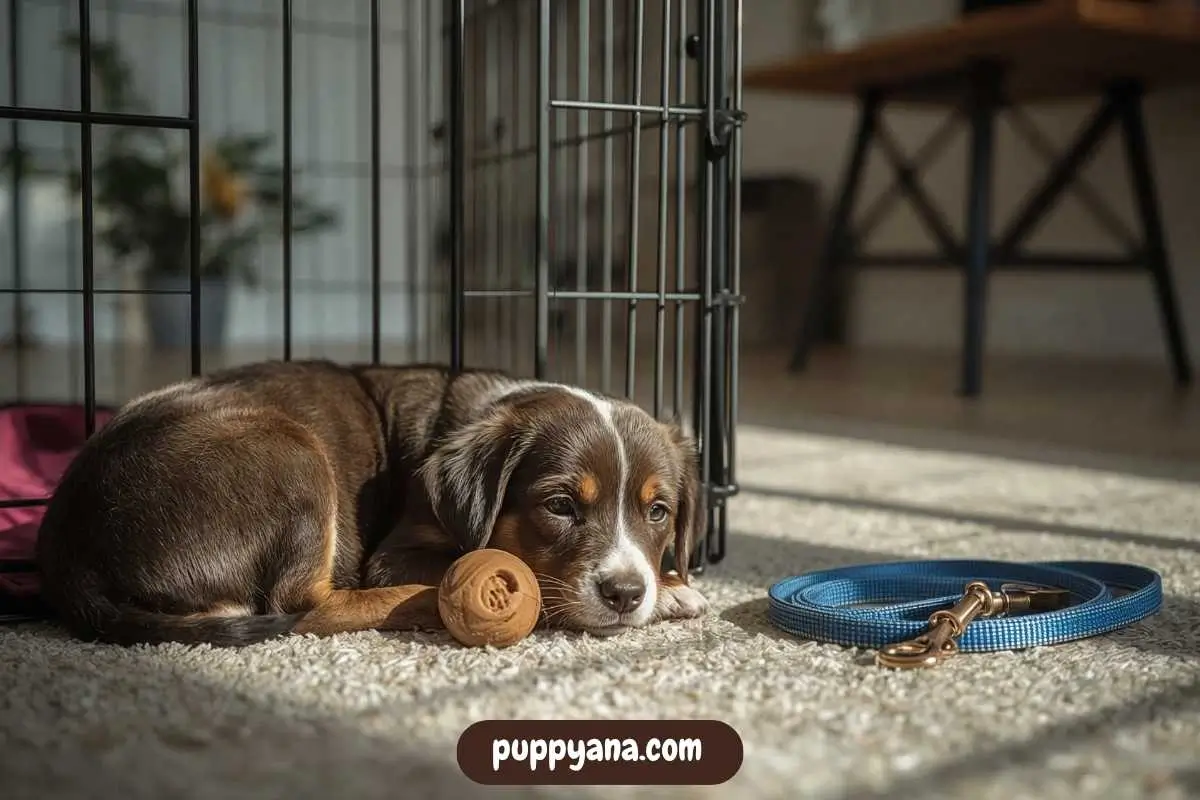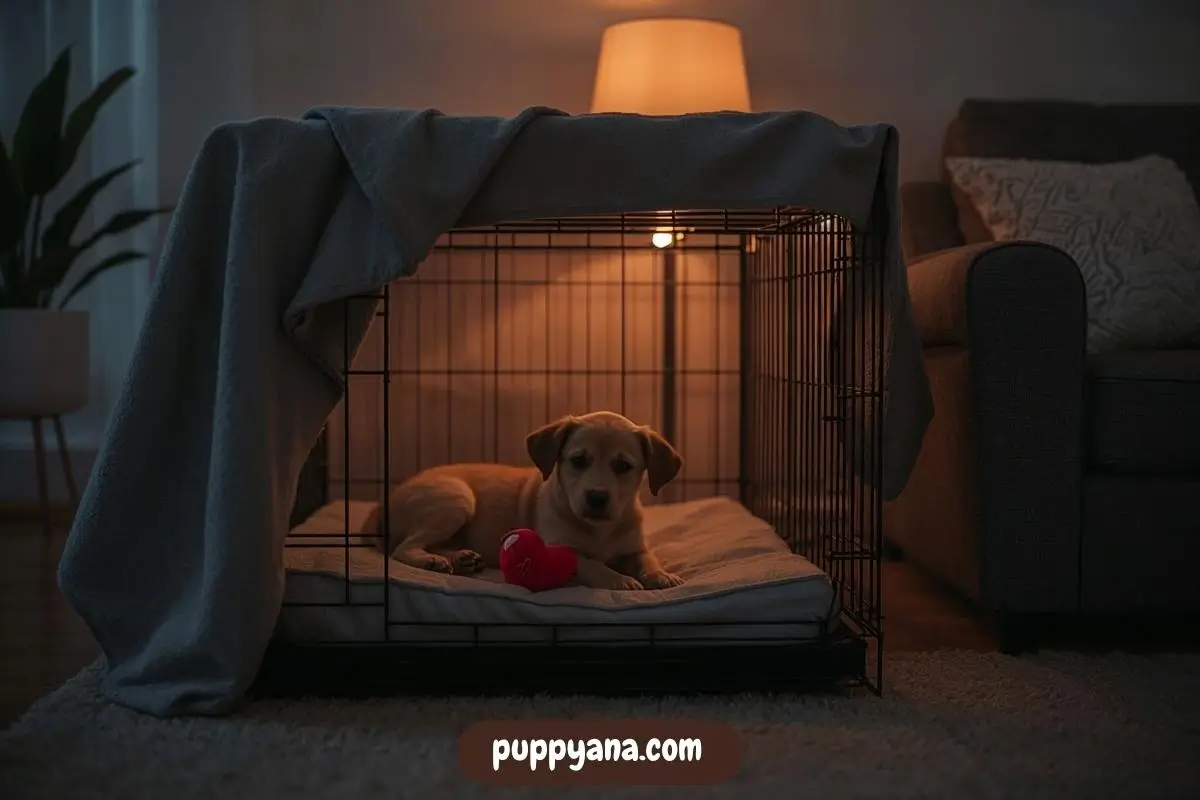You brought home a sweet, sleepy little puppy, and suddenly, they’re awake when you want to go to bed. Or they nap all day and zoom around like crazy at midnight.
You’re not alone.
At 3 months old, puppies experience one of the biggest changes in their development, more time awake, more play, and yes, still a whole lot of sleep. But how much is too much? When should they sleep? And how do you set a routine that works for both of you?
In this guide, you’ll learn exactly what a 3 month old puppy sleep schedule looks like, based on real-life experience raising multiple puppies and supported by veterinarians and trainers.
You’ll also get a full sample schedule (day and night), warning signs of overtiredness, and tips to help your puppy sleep better during crate training, teething, and growth spurts.
Sources like PetMD and VCA Hospitals agree: sleep is the single most important part of early puppy development besides food.
Let’s make sure your 12-week-old pup is getting just enough.

Table of Contents
ToggleHow Much Should a 3 Month Old Puppy Sleep?
Puppies at 12 weeks old generally sleep 16 to 20 hours per day, broken into naps, overnight sleep, and quiet time.
That means most puppies are only awake for 4–8 hours in short bursts spread out during the day.
Sleep usually breaks down like this:
- Overnight sleep: 6–10 hours (mostly uninterrupted)
- Naps during the day: Several naps totaling 6–10 hours
- Wake/play periods: 1–2 hours between naps
If this sounds like a lot, it’s because it is. Puppies are growing fast, and that takes energy and rest. According to the AKC, puppies grow most while sleeping, not while running around.
Real-life example: When I fostered a mixed-breed 12-week-old pup named Pepper, she’d nap from 9–11 AM, tire again by 1 PM, and completely crash from 6–8 PM before sleeping through most of the night.
Understanding your puppy’s natural sleep rhythm is the key to building a balanced routine.
Why Sleep is So Important at 3 Months Old
Let’s break down what’s happening inside your puppy’s body and brain right now.
At 12 weeks, puppies are:
- Experiencing rapid growth (height, bones, muscles)
- Developing mentally and emotionally
- Teething (which can disrupt sleep)
- Learning house training and basic commands
Sleep helps the brain store learning, manage stress, and recharge for more social play. This is why sleep is especially important after:
- Vet visits
- Walks or car rides
- Training sessions
- Meeting new people or dogs
Without enough sleep, puppies get cranky, mouthy, zoomy, and harder to train. A good sleep schedule prevents overstimulation and overexcitement.

Sample Sleep Schedule for a 3 Month Old Puppy
Every puppy is different, but a strong routine helps shape good behavior. Here’s a realistic daily sleep and wake routine I’ve used with multiple puppies at the 12-week mark.
Full-Day Puppy Sleep Schedule (12 weeks old)
| Time | Activity |
|---|---|
| 6:30 AM | Wake up + potty break |
| 6:45–7:15 AM | Short walk + play |
| 7:15–8:30 AM | Nap #1 |
| 8:30–9:00 AM | Breakfast + light training |
| 9:00–11:00 AM | Nap #2 |
| 11:00–12:00 PM | Play, training, short walk |
| 12:00–1:30 PM | Nap #3 |
| 1:30–2:30 PM | Calm enrichment: chew toy, sniffing games |
| 2:30–4:00 PM | Nap #4 |
| 4:00–5:00 PM | Walk, play session |
| 5:30–6:00 PM | Dinner |
| 6:00–7:00 PM | Wind-down time: cuddles, low activity |
| 7:00–8:30 PM | Nap #5 |
| 8:30–9:30 PM | Final play, last potty trip |
| 9:30–6:30 AM | Nighttime sleep (in crate or bed) |
PuppyAna recommends keeping puppies on sleep schedules like this until they are about 6 months old. It helps with crate training, bathroom habits, and bite control.
Remember, your pup might wake during the night for a potty break. That’s normal up to 14–16 weeks old, especially for smaller breeds.
Should You Wake a Sleeping Puppy to Keep Them on Schedule?
This is a common question for puppy owners:
“My puppy’s been asleep for almost 3 hours. Should I wake them?”
In most cases, no. Let sleeping puppies lie. Just like babies, puppies go through stages of deep and light sleep. Interrupting this process can lead to irritability, stress, or even play regression.
However, you can wake them gently if:
- They’re about to miss a meal
- You’re leaving the house soon
- You’re trying to reset a flipped day/night routine
- It’s been more than 3 hours of solid nap time
Keep the wake-up gentle:
- Open the crate door slowly
- Use a calm voice
- Offer a treat or toy to help them stretch awake
Where Should Your Puppy Sleep?
The ideal sleep setup depends on your home, but most puppies sleep best in:
- A crate or enclosed space (teaches calm and prevents chewing)
- Near your bed at night for comfort and bonding
- In a dark, quiet, cool room
- On a soft mat or blanket (not too fluffy for teething pups)
Avoid free-roaming during sleeping hours, even for calm puppies. It’s safer, especially during the chewing and potty-training stage.
Puppies who sleep in predictable places are more confident as they grow, especially during early crate introduction.
Giving clear sleep space and structure is one of the best ways to reduce anxiety long-term.

Signs Your Puppy Needs More Sleep
Not all tired puppies yawn. Some act wild, mouthy, or downright rude when overtired.
Here are signs your 3-month-old puppy needs a nap:
- Ignoring commands during play
- Zoomies that suddenly turn to barking or biting
- Clumsy movements or accidents
- Digging at beds or blankets
- Grabbing pant legs or fingers
- Growling during handling or petting
- Whining for attention or pacing
One high-energy Border Collie foster I had would always start biting the leash after 45 minutes of “awake time.” We learned that was his nap signal, and the moment we set a nap schedule, his behavior improved overnight.
Helping your dog rest before they reach meltdown mode improves behavior and speeds up house training.
How to Help Your Puppy Sleep Through the Night
At 12 weeks old, most puppies can sleep for up to 6–8 hours, sometimes with one bathroom break around 2–4 AM. Here’s how to make bedtime better:
Tips to improve overnight sleep:
- Use a crate near you so your pup feels safe
- Last potty break at 9–9:30 PM
- Avoid wild play before bed, choose cuddles or licking mats
- Add a warm toy, heartbeat plush, or safe chew
- Use a white noise machine, fan, or soft background music
Real-life tip: I had one foster pup who only slept peacefully if we draped a light blanket over the crate to create a den-like feel. After trying that? Nighttime wakeups went from 3 times to 1.

How to Create a Calm Bedtime Routine for Puppies
Bedtime success starts long before lights go out. A predictable, peaceful evening routine helps signal to your 3-month-old puppy that it’s time to settle down.
Here’s a routine I’ve used (and taught to clients) with great success:
Sample Calm Puppy Bedtime Routine:
- 7:30 PM – Light play or sniff game (nothing high-energy)
- 8:00 PM – Chew on a frozen Kong or lick mat in crate
- 8:30 PM – Last potty break
- 8:45 PM – Short cuddle or crate massage
- 9:00 PM – Lights dimmed, background noise on, cover crate lightly
Avoid wild games like tug, play-fighting, or jumping in the last hour. Replace them with calming activities like sniffing, chewing, or soft touch.
Real-life tip: One foster pup I trained wouldn’t settle at night until I added a 10-minute cuddle session with hand-feeding before bedtime. He fell asleep faster and stopped crying at night within 2 days.
Use the same pattern every evening. Consistency = confidence for your puppy.
How to Avoid Under- or Over-Napping
Sometimes, there’s too much sleep or too little. Here’s how to know if your schedule is off:
Your puppy might be sleeping too much if:
- They’re hard to wake
- They’re missing meals
- They seem disoriented when waking
(If this continues, contact your vet to rule out illness.)
Your puppy might be sleeping too little if:
- They’re hyper and destructive
- They’re snapping or biting hands more
- They struggle to settle in their crate
Stick to 5–6 nap breaks daily during this stage. Try scatter feeding, chew toys, or crate-only nap times to cue rest.
Sleep Regression at 3 Months: Is It Real?
Yes, your calm sleeper might suddenly resist the crate or start waking multiple times a night again, especially during growth spurts or new milestones.
This sleep regression is common around 12–14 weeks and usually only lasts 1–2 weeks.
Triggers include:
- Teething
- Separation anxiety
- Changing routines (new job schedules, visitors)
- Missed naps creating “overtired” states
Stay consistent. Go back to basics: crate structure, early bedtime, short night walk, and the same environment each night. Most regressions self-correct with routine.
What to Do if Your Puppy Cries in the Crate at Night
It’s 2 AM. Your puppy is crying in the crate again. Do you leave them? Ignore them? Rush over?
Here’s how to handle middle-of-the-night whining based on what’s actually worked for me and my clients:
If your puppy cries at night:
- Take them out for a quick, boring potty break. No play, no cuddles. Then back in the crate.
- Keep the crate beside your bed. Many puppies settle with your scent and soft voice nearby.
- Try a heartbeat sound toy or a white noise machine. These mimic comfort from their littermates.
- Avoid taking them into your bed “just this once.” That creates habits you’ll have to undo later.
I fostered a terrier mix who cried constantly at night. Once I moved the crate next to my bed with a ticking clock nearby, she settled by Day 3, and I finally got a full night of sleep.
If crying gets worse over several nights, consult your vet to rule out discomfort, illness, or poor crate fit.
Final Thoughts
Your 3 month old puppy sleep schedule is one of the most important parts of training, bonding, and managing behavior. Sleep shapes how your dog feels, learns, and plays. With 16–20 hours of rest spaced through the day, your pup will grow stronger, happier, and easier to manage.
I’ve seen firsthand how choosing the right sleep setup, schedule, and strategies can improve potty training, independence, and even commands like “sit” and “leave it.”
Stick to the rhythm. Adjust when needed. And enjoy the quiet moments while they last.

Frequently Asked Questions
How many hours should my 3-month-old puppy sleep?
About 16–20 hours total per day. This includes naps and nighttime sleep.
Can my puppy sleep through the night at 12 weeks?
Some do. Many still need one potty break around 2–4 AM, especially smaller breeds.
How long should my puppy nap at 3 months?
Naps generally last 1–2 hours. Your puppy should nap 4–5 times a day.
Where should a 3-month-old puppy sleep?
In a crate, pen, or confined space near you. Avoid letting them roam the house.
Is it okay if my puppy sleeps all day?
Yes, if energy levels are normal in between. If they act lethargic when awake, contact your vet.
What’s the best time to put a puppy to bed?
Between 8:30 and 9:30 PM usually works best once they’ve settled into a routine.
How can I stop my puppy from whining at night?
Make sure they’re pottied, fed, and not overtired. Keep the crate near you and use calming aids like soft background noise or a heartbeat toy.





